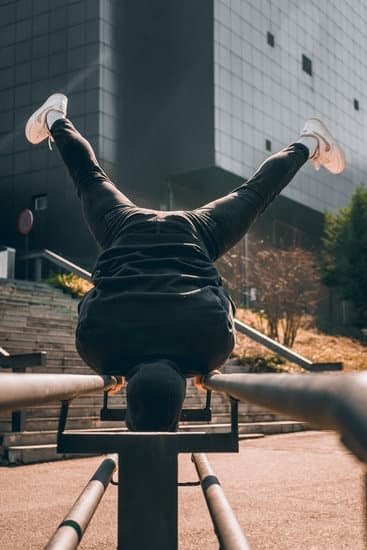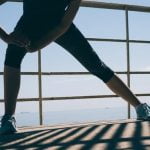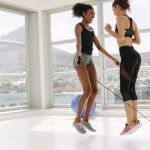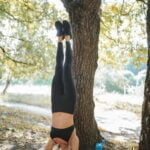Fitness Blender has become a household name in the realm of at-home workouts, offering a wide variety of exercise routines designed to cater to individuals of all fitness levels. One common question that often arises among Fitness Blender enthusiasts is, “Can I do Fitness Blender workouts barefoot?” This query stems from the growing interest in the benefits of exercising without shoes and the desire for a more natural movement experience.
Proper footwear during exercise is crucial to ensure safety, stability, and support, especially when engaging in high-impact or intense workout sessions. However, there are proponents of barefoot training who believe that working out without shoes can offer unique advantages such as improved balance, enhanced foot strength, and a more natural range of motion. These individuals argue that going shoeless can help activate muscles that are often neglected when wearing conventional athletic footwear.
While there are potential benefits to exercising barefoot, there are also risks to consider. Without the cushioning and support provided by shoes, individuals may be more susceptible to injuries such as sprains, blisters, or impact-related trauma.
Additionally, some people may find it challenging to maintain proper form or stability on certain surfaces without the assistance of supportive footwear. It is essential to weigh these potential drawbacks against the perceived benefits before deciding whether or not to do Fitness Blender workouts barefoot.
Benefits of Exercising Barefoot
Exercising barefoot has gained popularity in recent years, with many individuals turning to shoeless workouts for various reasons. When it comes to Fitness Blender workouts, the question of whether one can do them barefoot often arises. Working out without shoes can improve balance, foot strength, and promote natural movement patterns. Many fitness enthusiasts have found that exercising barefoot allows them to engage the muscles in their feet more effectively and develop a stronger foundation for overall physical activities.
One of the key benefits of working out without shoes is the improvement in balance and stability that it can offer. When you exercise barefoot, your feet are in direct contact with the ground, allowing for better proprioception and sensory feedback.
This heightened awareness enables you to make micro-adjustments in your movements, ultimately leading to improved balance over time. In Fitness Blender workouts that involve dynamic movements or balancing exercises, going barefoot can help you feel more grounded and stable throughout the routine.
In addition to enhancing balance, exercising without shoes can also contribute to strengthening the muscles in your feet. By eliminating the cushioning and support provided by footwear, your feet are forced to work harder to stabilize your body during exercise.
As a result, the intrinsic muscles of the feet are activated and strengthened, which can enhance overall foot function and reduce the risk of injuries related to weak foot muscles. Whether you are performing bodyweight exercises, cardio routines, or strength training with Fitness Blender videos, doing so barefoot may help you develop a stronger foundation from the ground up.
| Barefoot Exercise Benefits | Description |
|---|---|
| Improved Balance | Exercising without shoes enhances proprioception and sensory feedback for better balance. |
| Foot Strength | Barefoot workouts engage intrinsic foot muscles leading to strengthened foot function. |
| Natural Movement | Working out shoeless promotes natural movement patterns and muscle activation. |
Potential Risks of Barefoot Exercise
Exercising barefoot may offer various benefits, including improved balance, foot strength, and a more natural range of motion. However, it is essential to consider the potential risks associated with engaging in Fitness Blender workouts without shoes. While some individuals find barefoot exercise comfortable and effective, there are certain drawbacks that need to be taken into account.
Here are some potential risks of doing Fitness Blender workouts barefoot:
- Increased risk of foot injuries such as cuts, scrapes, or bruises
- Lack of arch support which can lead to discomfort or pain in the feet
- Potential for overloading certain muscles due to lack of cushioning and support
It’s crucial to acknowledge these risks and take precautions if you choose to exercise without shoes while following Fitness Blender routines. Being aware of the potential drawbacks can help you make an informed decision about whether going barefoot is the right choice for your workouts. Remember that safety should always come first, and listening to your body’s signals is paramount when engaging in any type of physical activity.
In order to minimize the risks associated with barefoot exercise during Fitness Blender workouts, here are some practical tips:
- Choose appropriate surfaces for working out barefoot, avoiding rough or uneven terrain
- Focus on maintaining proper form and alignment to reduce strain on your feet and lower body
- Gradually increase the duration and intensity of barefoot workouts to allow your feet to adapt over time
By being mindful of the potential risks involved and implementing these strategies for safe barefoot exercising, you can enjoy the benefits of working out without shoes while minimizing the chances of injury or discomfort.
Tips for Safe Barefoot Workouts
Exercising barefoot has gained popularity in recent years, with many fitness enthusiasts opting to do workouts without shoes for various reasons. When it comes to Fitness Blender workouts, the question of whether you can do them barefoot often arises. The short answer is yes, you can do Fitness Blender workouts barefoot, but there are some important factors to consider to ensure safety and effectiveness.
One of the key benefits of exercising barefoot is the improvement in balance and foot strength. Going shoeless allows your feet to move naturally and engage muscles that may not be activated when wearing shoes.
This can lead to better posture, stability, and overall performance during your Fitness Blender routines. Additionally, working out without shoes can promote better proprioception – the body’s awareness of its position in space – which is crucial for activities like strength training and high-intensity interval workouts.
However, there are potential risks associated with barefoot exercise that should not be ignored. Without the cushioning and support provided by athletic shoes, you may be more prone to injuries such as plantar fasciitis, tendon strains, or cuts from sharp objects on the floor.
It is essential to be mindful of your surroundings and choose appropriate surfaces when doing Fitness Blender workouts barefoot. By being attentive to your form and gradually increasing intensity, you can minimize the risk of injury and reap the benefits of exercising without shoes.
| Advantages | Considerations |
|---|---|
| Improved balance | Potential risk of injury |
| Enhanced foot strength | Lack of support compared to shoes |
| Natural movement patterns | Need for proper surface selection |
Personal Experiences
Asking the question, “Can I do Fitness Blender workouts barefoot?” may have sparked your curiosity about the experience of exercising without shoes. Many individuals have shared their personal experiences and observations after trying Fitness Blender workouts barefoot. Here are some anecdotes that shed light on what it’s like to exercise without footwear:
- One individual mentioned that they initially felt a bit hesitant to try doing Fitness Blender workouts barefoot due to concerns about safety and comfort. However, after giving it a try, they were pleasantly surprised by how it felt more natural and connected to the ground. They noticed improvements in their balance and stability during exercises like lunges and squats.
- Another person shared that going barefoot during Fitness Blender workouts helped them develop stronger foot muscles over time. They felt more aware of their foot positioning and could engage their arches and toes better during various movements. This resulted in a more efficient workout and reduced strain on their lower body.
- A different individual highlighted the sensation of freedom and agility they experienced when exercising without shoes. They mentioned feeling more grounded and focused on their form, leading to a deeper mind-body connection during each workout session. Additionally, they found that going barefoot improved their proprioception, which is essential for proper movement patterns.
These personal experiences showcase the various benefits individuals can derive from doing Fitness Blender workouts barefoot. While it may not be suitable for everyone, many people find value in exploring this practice for enhanced performance and connection with their bodies.
Expert Recommendations
Expert Insights on Barefoot Workouts
Fitness professionals have varying opinions on the topic of working out barefoot. While some believe in the benefits of barefoot exercise for improving foot strength and balance, others emphasize the importance of proper footwear to prevent injuries and provide support during high-impact activities. It is essential to consider individual factors such as foot structure, any existing injuries, and personal preferences when deciding whether or not to do Fitness Blender workouts barefoot.
Precautions for Barefoot Exercise
For those who choose to do Fitness Blender workouts without shoes, fitness experts recommend starting slowly and gradually increasing intensity to allow the feet to adapt to the new demands. Additionally, it is crucial to pay attention to the surface on which you are exercising – avoid rough or uneven terrain that can cause discomfort or injury. Maintaining good form throughout the workout can help reduce strain on the feet and lower limbs when exercising barefoot.
Guidelines for Safe Barefoot Workouts
To ensure safety and effectiveness when doing Fitness Blender workouts barefoot, fitness professionals suggest incorporating exercises that focus on strengthening the feet and ankles to improve stability and prevent injuries. Stretching exercises for the calves, hamstrings, and plantar fascia can also help prepare the feet for barefoot exercise. It is recommended to listen to your body and stop any activity that causes pain or discomfort while exercising without shoes.
Footwear Alternatives
When it comes to doing Fitness Blender workouts, some people may prefer not to exercise barefoot for various reasons. In such cases, there are alternative footwear options that can provide the necessary support and comfort during training sessions. While working out barefoot offers certain benefits, it is essential to choose appropriate footwear that meets individual preferences and requirements.
Running Shoes
One common option for Fitness Blender workouts is running shoes, which are designed to provide cushioning and support for the feet during high-impact activities. Running shoes can help absorb shock and reduce the risk of injuries while offering stability and traction on different surfaces. When selecting running shoes for exercise routines, it is important to choose a pair that fits well and provides adequate arch support to prevent discomfort or pain.
Cross-Training Shoes
Cross-training shoes are versatile footwear options suitable for a variety of exercises, including those featured in Fitness Blender workouts. These shoes offer a good balance of cushioning, stability, and flexibility, making them ideal for multidirectional movements and different types of training. Cross-training shoes can provide the necessary support needed during strength training, cardio exercises, and HIIT workouts without compromising comfort or performance.
Barefoot Training Shoes
For individuals who prefer a more minimalistic approach to footwear but still want some protection during Fitness Blender workouts, barefoot training shoes can be a suitable choice. These shoes mimic the feeling of being barefoot while providing a thin layer of cushioning and grip for added safety.
Barefoot training shoes can i do fitness blender workouts barefoot allow for better ground feel and proprioception while promoting natural foot movement during exercises. It is important to gradually transition into using barefoot training shoes to allow the feet to adapt to the new conditions effectively.
Conclusion
In conclusion, the debate on whether or not one can do Fitness Blender workouts barefoot ultimately comes down to personal preference and comfort level. While there are undeniable benefits to exercising without shoes, such as improved balance, foot strength, and natural movement, there are also potential risks to consider. It is essential to weigh these pros and cons carefully before deciding whether or not to go barefoot during your workouts.
For those who do choose to do Fitness Blender workouts barefoot, it is crucial to take certain precautions to ensure safety and effectiveness. Choosing appropriate surfaces that provide adequate support and cushioning, maintaining proper form throughout the exercises, and listening to your body are all key aspects of safely working out without shoes. By following these tips for safe barefoot workouts, you can minimize the risk of injury and maximize the benefits of exercising in this manner.
In the end, whether or not you should do Fitness Blender workouts barefoot is a personal decision that depends on your individual goals, preferences, and comfort level. It may be helpful to experiment with both barefoot and footwear options during your workouts to see what works best for you.
Ultimately, as long as you prioritize safety, proper form, and listen to your body’s cues, you can enjoy a successful workout experience with Fitness Blender – whether you choose to go shoeless or opt for supportive footwear.
Frequently Asked Questions
Is It OK to Exercise in Bare Feet?
Exercising barefoot can be both beneficial and risky, depending on the type of exercise and individual circumstances. While working out without shoes can improve balance, foot strength, and proprioception, it may also increase the risk of injury or discomfort.
Can You Do Strength Training Barefoot?
Strength training barefoot is generally acceptable for most people, as long as they are mindful of their surroundings and the specific exercises being performed. Barefoot strength training can provide a stable base for lifting weights, but caution should be taken to avoid dropping heavy objects on unprotected feet.
Is It Safe to Do Lunges Barefoot?
Doing lunges barefoot is generally safe, as long as proper form and technique are maintained throughout the exercise. Lunges help improve lower body strength and stability, but individuals with foot conditions or sensitivities should consider using supportive footwear for added protection.

Passionate about providing useful information to anyone with an interest in the field of Personal Training, I strive to pass on to our readers quality information and to answer any questions about Personal Trainers, the work they do and how to become one.





